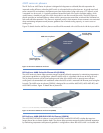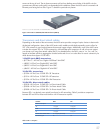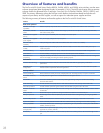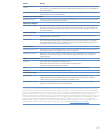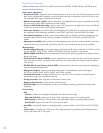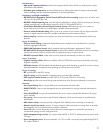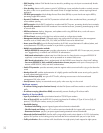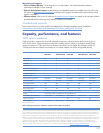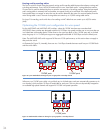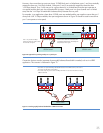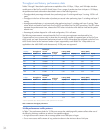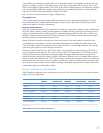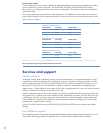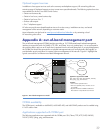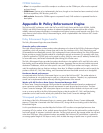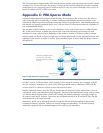
34
Routing and forwarding tables
The ProCurve 6600 Switch Series has several routing and forwarding table features that enhance routing and
switching performance. Every NG/NGX interface has its own “best-match prefix” routing table that contains
IP routes and is used for determining how to route the vast majority of incoming packets. Using the best-match
prefix routing table is extremely fast and enables wire-speed routing to be achieved. If the best-match prefix
routing table does not contain an entry that can be used to determine the route of a received packet, then the
main routing table is used. The main routing table can contain up to 10,000 routing table entries.
For Layer 2 forwarding, each switch has a forwarding or MAC table that can contain up to 65,536 entries
(64K).
Optimizing the 10-GbE port configuration for wire speed
For the 6600-24XG and 6600-24G-4XG switches, where the 10-GbE interfaces are oversubscribed
40G:28.8G, these switches are designed to deliver full 10-Gbps wire speed to either one or two ports that are
in a linked state with another device. When three or four ports per block of four 10-GbE ports are in a linked
state, the group of 4 x 10-GbE ports support an aggregate bandwidth of 28.8 Gbps across the linked ports.
Note: The 6600-48G-4XG switch supports full line rate 10-Gb performance, so this section does not apply to
that particular switch.
As illustrated in Figure 18, internally, there are two 14.4-Gbps channels between each four-port 10-GbE block
and the switch fabric.
Fabric Modules
10 GbE ports
14.4 Gbps
Channel
14.4 Gbps
Channel
1
2 3
4
Fabric modules
10-GbE ports
14.4-Gbps
channel
1
2 3
4
Fabric Modules
10 GbE ports
14.4 Gbps
Channel
14.4 Gbps
Channel
1
2
3
4
Fabric modules
10-GbE ports
1
2
3
4
or
14.4-Gbps
channel
14.4-Gbps
channel
14.4-Gbps
channel
Figure 18: 4-port 10-GbE blocks showing how ports are grouped to a 14.4-Gbps channel
When any two 10-GbE ports within a 4-port block are in a linked state, each port automatically operates on its
own channel, which provides 10 Gbps of bandwidth for each port. The two ports are dynamically mapped to
an available high-speed channel and support full 10-GbE wire-speed operation.
Fabric Modules
10 GbE ports
14.4 Gbps
Channel
14.4 Gbps
Channel
1
4
2
3
Fabric modules
10-GbE ports
1 4 2 3
14.4-Gbps
channel
14.4-Gbps
channel
Figure 19: 10-GbE module architecture showing four ports grouped to a 14.4-Gbps channel



